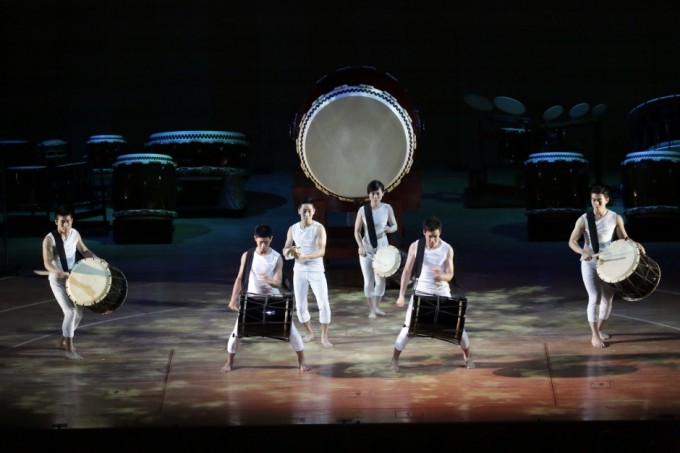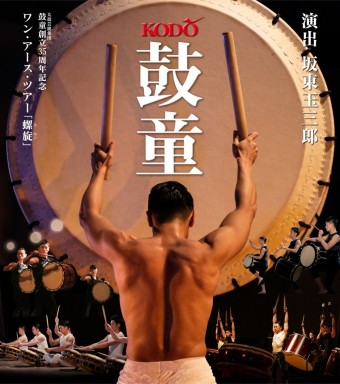“Kodo One Earth Tour 2016: Spiral” – An Overview
“Kodo One Earth Tour 2016: Spiral” – An Overview
Over the past three years, the “Kodo One Earth Tour” productions “Mystery” (2013), “Eternity” (2014), and “Chaos” (2015) have intentionally excluded the most iconic symbol of the ensemble: the o-daiko, or big drum. Instead, these past three years of performances have presented Kodo’s next generation performing new compositions — a telling sign of the group’s determination to move forward. The latest production, “Spiral,” begins by taking a look back at the innovative repertoire composed under the guidance of Artistic Director Tamasaburo Bando between 2009 and 2013.
The programme starts with a rousing piece, Kei Kei. The full cast takes to the stage playing taiko that are slung from their shoulders, thereby allowing the performers mobility amongst the reverberations. This captivating variation of the okedo-daiko (barrel drum) is further showcased in Phobos (2009), Mute (2013), and Kusa-wake (2013).
In Spiral, the performers are dressed in either all black or all white, their sleeveless costumes timeless and universal, sleek and subtle. The form-fitting outfits do not belong to any one culture. This allows today’s Kodo ensemble to freely express its sound without being culturally bound by their former stage attire: the Japanese knotted headband and workman’s coat, and the loincloth traditionally worn by each of Kodo’s big drum soloists.
After its hiatus in recent One Earth Tour productions, the monolithic o-daiko returns to the stage in Spiral. In this performance, the drum appears in the programme under the familiar title: O-daiko. The name “O-daiko” has been honored by Kodo since 1975, when the mighty drum first appeared in the programmes of Kodo’s antecedent group, known as Ondekoza. The taiko remains the same, but this next generation of drummers delivers a dynamic new style of performance. There is no drum cart with lanterns, no loincloths, and no cymbals or flutes. Instead, the massive instrument is flanked by its Western counterparts the timpani and bass drum, which Kodo uses to conjure deep and powerful cadences. This rhythmic universe promises to stir an audience to its very core.
The first act ends with Kodo’s timeless signature piece, Monochrome (1977). Intricately crafted by modern composer Maki Ishii, Monochrome is a thorough investigation of the tonal range of the shime-daiko, a high-pitched roped drum. This piece contrasts the simple yet wild nature of taiko performance, which is emblematic of Kodo’s direction today, as its next generation forges forward using a balance of raw power and honed skills.
The second act commences with Color (2009), which utilizes the same roped drums of Monochrome, but in a completely different way. The performers put down their drumsticks and experiment with different percussive sounds. They tap the drums with their fingernails. They rub the drums with their hands, and they throw clusters of jingling bells onto the skins of the drums. Humor reveals itself in their onstage interactions as they rhythmically hum, sigh and shout to the beat. After the entrancing intensity of Monochrome, this light-hearted approach comes as a welcome relief.
For the next piece, the stage darkens for the beautiful and captivating Ake no Myojo (2012). Female performers in flowing black skirts take to the stage to drum, sing, and dance as they spin in a perpetual state of sound and motion. Afterwards, the melodic bamboo flutes in Yuyami (2013) create an indescribable sense of nostalgia, which leads directly into the brand new piece, Ayaori (2016). An exploration of the myriad sounds of the odeko-daiko, Ayaori utilizes the performers’ dexterity and a range of drumsticks to conjure sharp and rich tones while deftly weaving them into a coherent whole.
The finale arrives as the title piece, Rasen, which means “spiral.” Rasen features eight performers, the main soloist playing a large flat hirado drum. Surrounding him are seven performers on nagado (long) taiko, okedo (barrel) taiko, and timpani. This powerful octet produces rhythms of complexity and precision while revealing the rich variety of drumming techniques that Kodo has discovered during its evolution. To compose Rasen, Tamasaburo Bando brought a range of Kodo performers into the creative process. Fresh newcomers joined young up-and-coming performers and core soloists, as well as veterans whose careers span some three generations with Kodo.
As the title suggests, Rasen is a whirling helix depicting the evolution of Kodo through its decades of rich history. Phrases from exemplary pieces such as Yatai-bayashi (1973), Miyake (1982), and Tomoe (2003) transport the audience from era to era. It’s a soaring journey through Kodo’s past and into its future. As the strong winds of change blow through the ensemble, this climactic finale shows Kodo’s unwavering footing. The ensemble fully acknowledges its thirty-five year history — all while clearly proclaiming its intention to look to the future.
When Tamasaburo Bando assumed the role of Kodo artistic director in 2012, he vowed to raise the artistry of taiko performing arts. The Spiral programme boldly demonstrates that his goal and his vision have manifested themselves in full.
Production Details
http://www.kodo.or.jp/news/20160900oet_en.html
2016 Japan Tour Schedule
http://www.kodo.or.jp/oet/index_en.html#schedule26a
Dec. 14 (Wed), 2016 Fukuoka Performance
http://www.kodo.or.jp/oet/20161214a_en.html
Dec. 17 (Sat), 18 (Sun), 2016 Osaka Performances
http://www.kodo.or.jp/oet/20161217-18a_en.html
Dec. 21 (Wed)–25 (Sun), 2016 Bunkyo Civic Hall, Bunkyo Ward, Tokyo
http://www.kodo.or.jp/oet/20161221-25a_en.html














